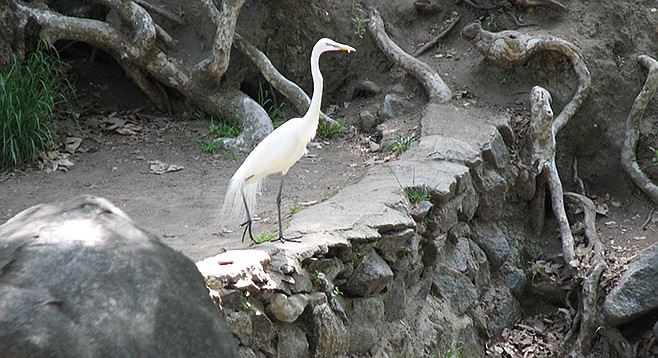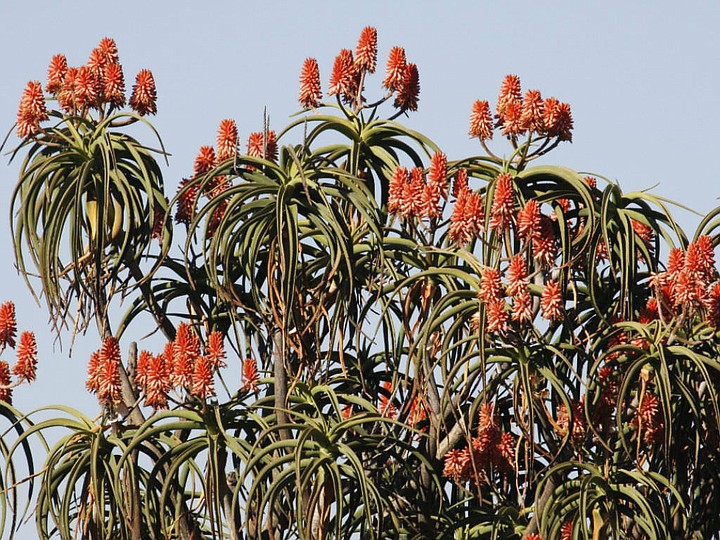 Facebook
Facebook
 X
X
 Instagram
Instagram
 TikTok
TikTok
 Youtube
Youtube

Toyon, or “Christmas-berry,” one of the more distinctive shrubs of Southern California’s native chaparral plant community, are now flaunting clusters of bright red berries. In coastal San Diego, toyon can be found wherever large patches of native vegetation survive, but especially in the thick chaparral covering some northfacing slopes.
Toyon branches may look inviting to cut as a Christmas wreath — but they’re protected by California state law.

Shorebird-Watching enters its most agreeable season this month and next, with migrant and resident birds sharing common winter grounds. Egrets, herons, terns, and a variety of other species provide endless entertainment as they go about the business of fishing and feeding in San Diego County’s coastal wetlands.
Publicly accessible wetlands include the following (listed north to south): San Luis Rey River mouth, Buena Vista Lagoon, Agua Hedionda Lagoon, Batiquitos Lagoon, San Elijo Lagoon, San Dieguito Lagoon, Los Peñasquitos Lagoon, San Diego River flood channel (south of Sea World Drive), Sweetwater River marsh, southwest San Diego Bay, and Tijuana River Estuary. Many of the same birds can also be seen on the shores of inland reservoirs such as Lake Murray and Lake Miramar.

Tree Aloes, the familiar succulent plants with red-hot-pokerlike flower clusters, are at their showy best in January. Large clumps of aloes can be seen at La Jolla Cove, Mission San Diego de Alcalá, and scattered along the embankments overlooking Highway 163 in Balboa Park.
The longest nights of the year in the Northern Hemisphere are Dec. 21 and 22. Dec. 18 was the full moon. The full moon of the Christmas season rides higher across the sky at midnight than at any other time of year. Stay up late enough to watch the Ursid meteor shower which is likely to peak the morning of Dec. 22.
The above comes from the Outdoors listings in the Reader compiled by Jerry Schad, author of Afoot & Afield in San Diego County. Schad died in 2011. Planet information from SkyandTelescope.org.


Toyon, or “Christmas-berry,” one of the more distinctive shrubs of Southern California’s native chaparral plant community, are now flaunting clusters of bright red berries. In coastal San Diego, toyon can be found wherever large patches of native vegetation survive, but especially in the thick chaparral covering some northfacing slopes.
Toyon branches may look inviting to cut as a Christmas wreath — but they’re protected by California state law.

Shorebird-Watching enters its most agreeable season this month and next, with migrant and resident birds sharing common winter grounds. Egrets, herons, terns, and a variety of other species provide endless entertainment as they go about the business of fishing and feeding in San Diego County’s coastal wetlands.
Publicly accessible wetlands include the following (listed north to south): San Luis Rey River mouth, Buena Vista Lagoon, Agua Hedionda Lagoon, Batiquitos Lagoon, San Elijo Lagoon, San Dieguito Lagoon, Los Peñasquitos Lagoon, San Diego River flood channel (south of Sea World Drive), Sweetwater River marsh, southwest San Diego Bay, and Tijuana River Estuary. Many of the same birds can also be seen on the shores of inland reservoirs such as Lake Murray and Lake Miramar.

Tree Aloes, the familiar succulent plants with red-hot-pokerlike flower clusters, are at their showy best in January. Large clumps of aloes can be seen at La Jolla Cove, Mission San Diego de Alcalá, and scattered along the embankments overlooking Highway 163 in Balboa Park.
The longest nights of the year in the Northern Hemisphere are Dec. 21 and 22. Dec. 18 was the full moon. The full moon of the Christmas season rides higher across the sky at midnight than at any other time of year. Stay up late enough to watch the Ursid meteor shower which is likely to peak the morning of Dec. 22.
The above comes from the Outdoors listings in the Reader compiled by Jerry Schad, author of Afoot & Afield in San Diego County. Schad died in 2011. Planet information from SkyandTelescope.org.
Comments